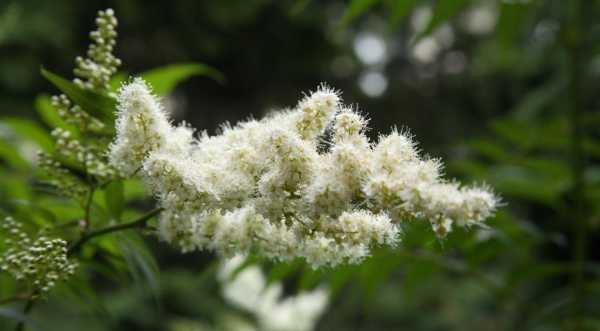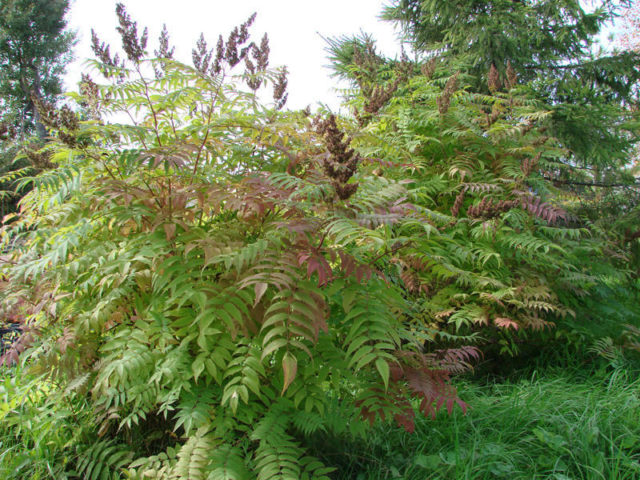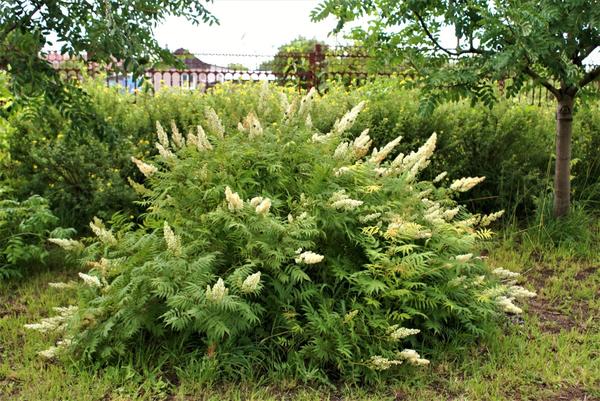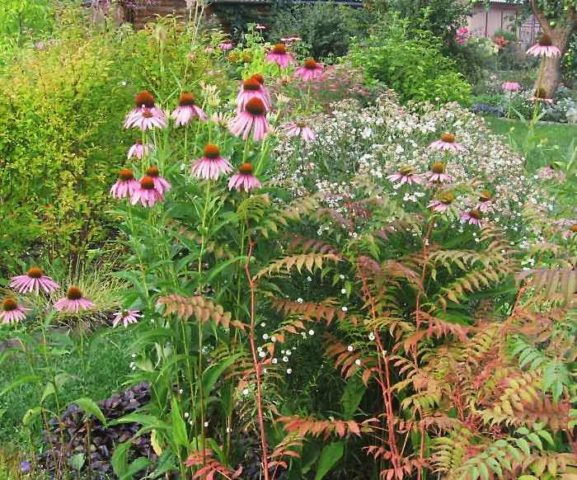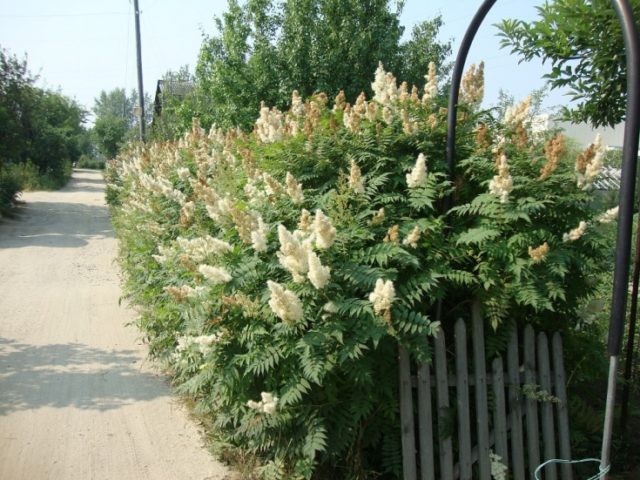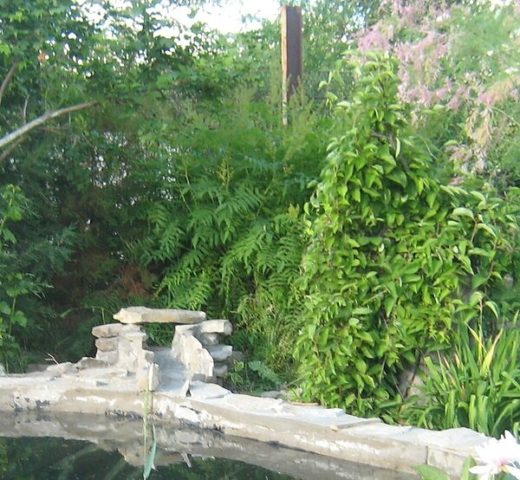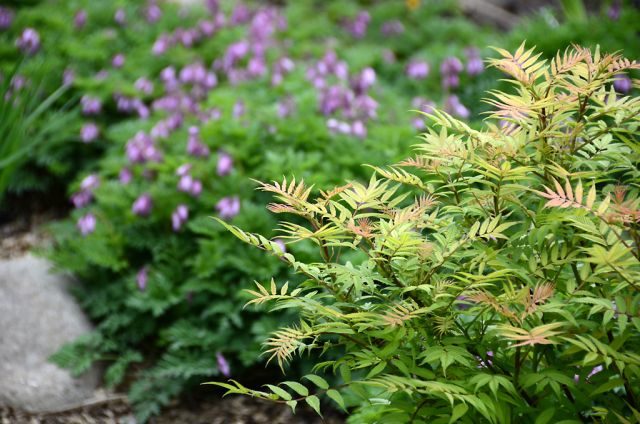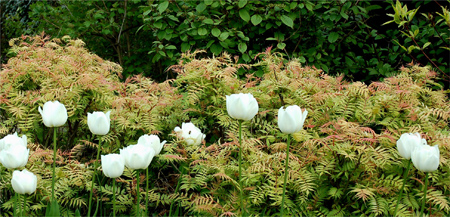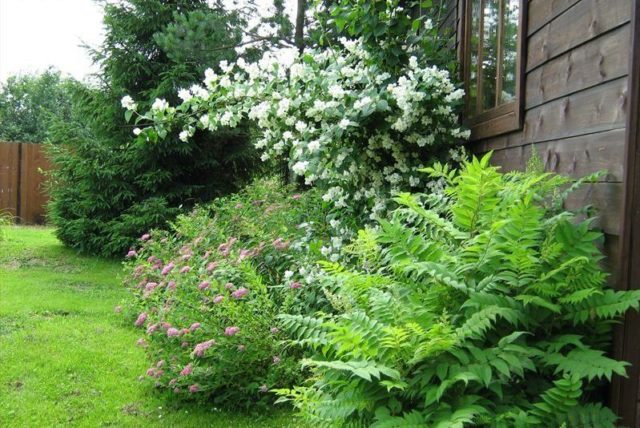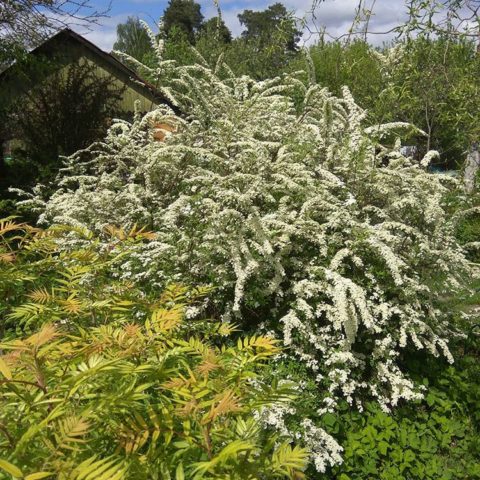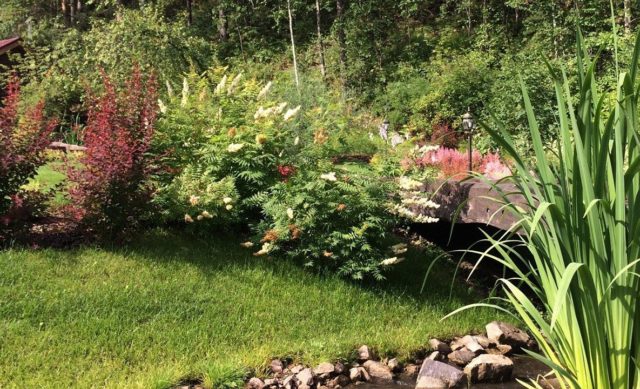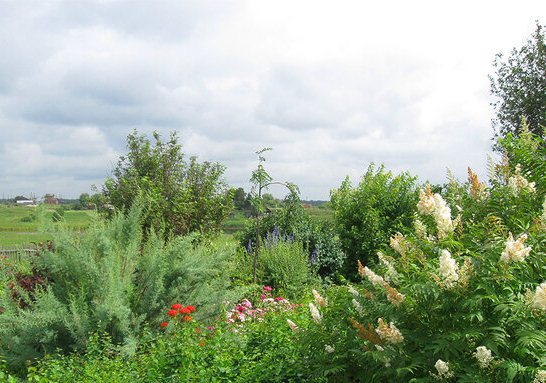Content
- 1 Features of mountain ash in the landscape design of the garden
- 2 What varieties of mountain ash are used in garden design
- 3 Types of compositions with fieldfare
- 4 What does fieldberry combine with?
- 5 Field care in the landscape design of the cottage
- 6 Photo of mountain ash in landscape design
- 7 Conclusion
The mountain ash, often called the mountain ash spirea, is a beautiful plant up to 3 m high.It got its name due to the characteristic carved leaves that give it a resemblance to mountain ash, however, unlike it, the mountain ash is not a tree, but a shrub, and its fruits are not have medicinal and gastronomic properties. At the same time, this plant copes with its main function - aesthetic - just fine. Its high decorativeness and unpretentiousness did not go unnoticed among gardeners and made mountain ash in landscape design a real favorite among deciduous crops.
Features of mountain ash in the landscape design of the garden
The interest of landscape designers in the use of mountain ash in the design of gardens, parks and green areas is understandable. The openwork foliage of this plant changes color following the change of seasons, which allows it to remain a real decoration of the site throughout the year. So, in the spring, young shoots of fieldfare have a delicate, pink-lilac color. With the onset of summer, they acquire a juicy bright green hue, while in the fall the leaves of mountain ash-leaved spirea turn red and yellow.
In addition to the extremely beautiful crown, the mountain ash is also distinguished by its lush flowering. In early June, the plant is covered with large paniculate inflorescences up to 25 cm in length, consisting of many white fragrant flowers. The flowering period lasts until the end of August, after which the flower petals fall off, but the inflorescences themselves remain on the shrub. They should be pruned periodically to make the plant look neat and well-groomed.
Other features of the mountain ash is its rapid growth rate. With proper care, the plant grows strongly in breadth, therefore, when planting, it is necessary to maintain a distance of at least 80 cm between the plants. The shrub should be pruned regularly to form a more compact silhouette. This can be done up to 3 times a year without fear of damaging the plant, since it is successfully recovering after cutting.
In addition, under favorable conditions, the culture produces abundant root growth. To prevent mountain ash from capturing nearby territories, it will not be superfluous to install a protective ring around the rhizomes of the plant.
What varieties of mountain ash are used in garden design
The most popular in Europe among all varieties of mountain ash are the following varieties:
- Stellifila;
- Sem.
These varieties of mountain ash are considered highly decorative and are actively used in landscape design in many countries, including Russia.
- Stellifila variety immediately attracts attention due to fragrant inflorescences and spectacular leaves, which on the back have a characteristic pubescence of an unusual brown color. This plant reaches up to 3 m in height and is known for its ability to easily tolerate frosts down to -30 ° C.This feature allows you to grow such a shrub not only in the conditions of the Middle Lane, but also in colder regions;
- Sem variety, unlike the previous variety of mountain ash, it is more compact and undersized: an adult plant grows up to 1 m, so owners of small plots often prefer it. In the period from June to July, the shrub is decorated with large panicles of creamy white flowers, which give the plant a particularly elegant look. The Sem cultivar does not grow as actively as the fieldfare Stellifila, and gives less growth, which makes it an ideal candidate for creating landscape compositions of any level of complexity.
Types of compositions with fieldfare
Speaking about the role of mountain ash in landscape compositions, it is worth noting that this spectacular plant is quite self-sufficient, and therefore can be used as a solitary shrub for decorating a lawn in a garden or public garden.
It does not lose its charm in group plantings when decorating rockeries and alpine slides. In such landscape compositions, the leaves of the mountain ash spirea complement the companion plants, it serves as an unobtrusive openwork background for them.
Due to the fact that mountain ash can tolerate pruning and has a dense crown, it can compete with thuja, hawthorn, cotoneaster and other plants when creating a hedge around the perimeter of the site.
Smaller fieldbushes, for example, specimens of the Sem variety, planted in a row, form stunningly beautiful borders that can delimit the functional areas of the garden or complement the landscape design of the adjoining area.
The mountain ash-leaved spirea, planted along the reservoirs, looks unusually attractive. However, it is advisable to place this plant near the water not only from the point of view of aesthetics. Near a pond or stream, the shrub will not suffer from a moisture deficit, and its rapidly growing roots will prevent the coastline from crumbling.
In general, rowan-leaved spirea can be attributed to universal plants, since it is able to harmoniously fit into almost any informal style landscape design, be it a provincial estate, an English garden or an imitation of wildlife.
What does fieldberry combine with?
The mountain ash-leaved field can become the most expressive element of the garden if suitable companion plants are placed in the immediate vicinity.
So, ground cover and undersized plants of bright colors will be able to emphasize the exquisite beauty of the shrub:
- dahlias;
- viola;
- tulips;
- stonecrop;
- geycher;
- hosts;
- badans.
The snow-white inflorescences of fieldfare are favorably distinguished against the background of various conifers, such as thuja, pine, juniper or spruce. This culture is advantageously combined with other ornamental shrubs, the flowers of which are characterized by a bright color. Among them are:
- lilac;
- spirea;
- scumpia;
- jasmine;
- bladderworm.
An interesting result can be achieved by planting different types of fieldfare in the same zone of the garden, which do not have the same flowering time. This will allow you to admire the unusually beautiful flowers throughout the season.
Field care in the landscape design of the cottage
The high decorative value of mountain ash is complemented by its amazing unpretentiousness to growing conditions. And therefore, caring for him in the landscape design of a summer cottage or garden is not too difficult. It is enough to remember a few basic features in order to preserve the beauty and health of the plant for a long time:
- Fieldfare successfully takes root in almost any garden soil and does not require a special substrate for healthy growth.
- Despite the ability of the shrub to survive short periods of drought or waterlogging, this plant prefers moderately moist soil and regular watering at least 2 times a week.
- To retain moisture in the soil, it is advisable to mulch the culture with compost or peat after each watering.
- Due to its enviable winter hardiness, which allows the field ash to withstand frosts down to -40 ° C, it does not need shelter for the winter, even in regions with severe frosts.
- Once or twice a month, the roots of the plant should be gently loosened, being careful not to injure them. Deep digging of soil under the bush is not recommended.
- It is worth paying due attention to pruning fieldbus. It should be carried out in early spring or after flowering shrubs, shortening branches up to 1 m in the process, cutting off old shoots and removing panicles of last year's inflorescences.
- Due to its superficial root system, which has a rather compact size, fieldfare is suitable not only for cultivation in the open ground of the garden, but also for growing in pots and containers.
Photo of mountain ash in landscape design
You can talk a lot about the decorativeness of mountain ash in landscape design, but you can fully appreciate the beauty of this shrub by looking at the photos below.
Conclusion
The mountain ash field in landscape design can look quite interesting both on its own and in the environment of other cultures. By choosing the right neighboring plants, you can create compositions that are unique in appearance, which, with proper care, will delight the eye for more than one year.

